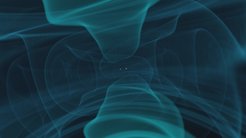LIGO-Virgo-KAGRA detect most massive black hole merger to date
Gravitational waves from massive black holes challenge current astrophysical models

To the point:
• The two LIGO observatories in the USA have detected the merger of the most massive black holes ever observed with gravitational waves.
• At 100 and 140 times the mass of the Sun, the existence of these black holes cannot be explained with standard models of how stars evolve.
• Models that account for the complex dynamics of highly spinning black holes, which were developed at the AEI, were used to analyze the signal and extract astrophysical information from it.
At the GR24 & Amaldi16 meeting in Glasgow, UK, the LIGO-Virgo-KAGRA (LVK) Collaboration has today announced the detection of the merger of the most massive black holes ever observed. Both LIGO observatories in the USA detected the gravitational waves from the cosmic collision. The signal, designated GW231123, was observed during the fourth joint observing run (O4) of the LVK detectors on 23 November 2023.
“Forbidden” black holes
The two black holes that merged were approximately 100 and 140 times the mass of the Sun. Black holes this massive are “forbidden” through standard stellar evolution models. One possible explanation is that the two black holes in this binary formed through earlier mergers of smaller black holes. The merger produced a final black hole more than 225 times the mass of our Sun.
In addition to their high masses the two black holes are also rapidly spinning, making this a uniquely challenging signal to interpret and suggesting the possibility of a complex formation history. To date, approximately 300 black-hole mergers have been observed through gravitational waves, including candidates identified in the ongoing O4 run. Until now the most massive confirmed black-hole binary was the source of GW190521, with a much smaller total mass of “only” 140 times that of the sun.
A record-breaking system
The high mass and extremely rapid spinning of the black holes in GW231123 push the limits of both gravitational-wave detection technology and current theoretical models. “Analyzing this exceptional event is challenging, and we’ll need to refine our models and incorporate additional physical effects to gain a deeper understanding of the signal and its origin,” says Alessandra Buonanno, director at the Max Planck Institute for Gravitational Physics (Albert Einstein Institute/AEI) in the Potsdam Science Park. Lorenzo Pompili, a PhD student at the AEI Potsdam and a member of the team that built the model, adds: “In order to extract accurate information from the signal, we developed waveform models that account for the complex dynamics of highly spinning black holes.”
Probing the limits of gravitational-wave astronomy
The signal pushes the instrumentation and data-analysis capabilities to the edge of what’s currently possible. “Although GW231123 was one of the strongest signals observed in the current observing run so far, it was unusually difficult to measure precisely, because its source was so complex,” says Héctor Estellés Estrella, a postdoctoral researcher on the AEI Potsdam team that developed the waveform model. “We are challenged to continuously refine our analysis and improve our waveform models used to interpret such extreme events.” The researchers will also need accurate models for future detections with current and upcoming detectors.
“As this event pushes the boundaries of gravitational-wave astronomy and what can be achieved with our instrumentation, it is becoming increasingly important to make our detector more sensitive,” says Karsten Danzmann, director at the AEI in Hannover. “At GEO600 near Hannover, Germany, we have pioneered, developed, and tested many of the technologies that make current detectors so sensitive.”
Gravitational-wave detectors such as LIGO in the United States, Virgo in Italy, and KAGRA in Japan began their fourth joint observing run in May 2023 and will continue observing until 18 November 2025. “Within the LVK collaborations, we are currently finalizing our analysis of all signals found during the first half of the run, which ended in January 2024,” explains Frank Ohme, who leads an independent Max Planck Research Group at AEI Hannover. “We are looking forward to publishing the results later this summer.”
The LIGO-Virgo-KAGRA Collaboration
LIGO is funded by the NSF, and operated by Caltech and MIT, which conceived and built the project. Financial support for the Advanced LIGO project was led by NSF with Germany (Max Planck Society), the U.K. (Science and Technology Facilities Council) and Australia (Australian Research Council) making significant commitments and contributions to the project. More than 1,600 scientists from around the world participate in the eQort through the LIGO Scientific Collaboration, which includes the GEO Collaboration. Additional partners are listed at https://my.ligo.org/census.php.
The Virgo Collaboration is currently composed of approximately 880 members from 152 institutions in 17 diQerent (mainly European) countries. The European Gravitational Observatory (EGO) hosts the Virgo detector near Pisa in Italy, and is funded by Centre National de la Recherche Scientifique (CNRS) in France, the Istituto Nazionale di Fisica Nucleare (INFN) in Italy, and the National Institute for Subatomic Physics (Nikhef) in the Netherlands. A list of the Virgo Collaboration groups can be found at: https://www.virgogw.eu/about/scientific-collaboration/. More information is available on the Virgo website at https://www.virgo-gw.eu.
KAGRA is the laser interferometer with 3 km arm-length in Kamioka, Gifu, Japan. The host institute is Institute for Cosmic Ray Research (ICRR), the University of Tokyo, and the project is co-hosted by National Astronomical Observatory of Japan (NAOJ) and High Energy Accelerator Research Organization (KEK). KAGRA collaboration is composed of over 400 members from 128 institutes in 17 countries/regions. KAGRA’s information for general audiences is at the website https://gwcenter.icrr.utokyo.ac.jp/en/. Resources for researchers are accessible from http://gwwiki.icrr.utokyo.ac.jp/JGWwiki/KAGRA.
GW231123













